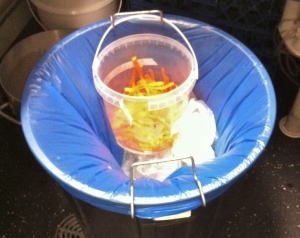Nutrient cycling: What? Why? And how to design one
What is nutrient cycling and why is it so important?
“…nutrient cycling refers to the biodiversity within community food web systems that loop organic nutrients or water supplies back into production.” Wikipedia
You may be familiar with Moby’s track from a few years back titled: “We are all made of stars” which I believe to be a reference to Carl Sagan’s quote:
“The nitrogen in our DNA, the calcium in our teeth, the iron in our blood, the carbon in our apple pies were made in the interiors of collapsing stars. We are made of star stuff.”
― Carl Sagan
This brings me back to day one of my recently completed Permaculture Design Certificate course when Nick told us: “There’s no such thing as waste in nature”. As you can see from Sagan above, nature recycles EVERYTHING.
Something else I learned on the PDC was a little less cool and very disturbing. As we humans charge along burning up fossils, mining minerals and metals to achieve our human greatness and “progress” it’s not just oil that has peaked. There are several other valuable minerals vital to our wellbeing that we are using up as fast as we can extract them. We are looking down the barrel of peak minerals such as phosphorous. It’s not exactly light and happy reading but the takeaway is “make the most of what we have and recycle as much of it as we can.”
The good news is that recycling most of this stuff is easy. You’ve heard of composting, right?
With all this in mind hopefully you can see why Urban GreenSpace is all about nutrient cycling and helping to remind people of the value of natural resources.
When Urban GreenSpace start a new job, we look at the client’s business or home to see what we can do to stem the flow of nutrients and close the loops as best we can. Granted we won’t be able to fully “close the loop” as we realise the shortage of space, the fact people “eat and leave” and that harvesting wee and composting poop isn’t really an option in a commercial food premise or inner city apartment block (although the wee thing is quite doable if you’re a bloke 😉
What we can do is design systems that capture the easy stuff such as food prep waste, coffee grounds, waste paper and compost it.
Another benefit from reducing waste is that it can reduce your garbage bills significantly.
I have previously mentioned yet another good reason to cycle nutrients is that rotting organic waste in landfill produces methane, which is a potent greenhouse gas then there’s the transportation costs and emissions to consider as well as the nutrient loss.
OK enough about the whys, let’s get to the hows and look at an example.
Timbah is a busy wine bar in Glebe. Lately they were recognised as being one of the Top 10 Sydney Bars With Food. Setting up a nutrient cycling system for such a place relies on relationships and systems.
Personally I think that setting up a system like this cannot be done without the head chef being in on the act because their rule is law in the kitchen and they say what comes in and goes out. The boss can say what they like but it’s the head chef that puts everything into place. I have worked hard to build my relationship with head chef, Daphne. She gets what I am aiming for and I really respect her vision as a chef. Together we have worked out a system that works pretty well.
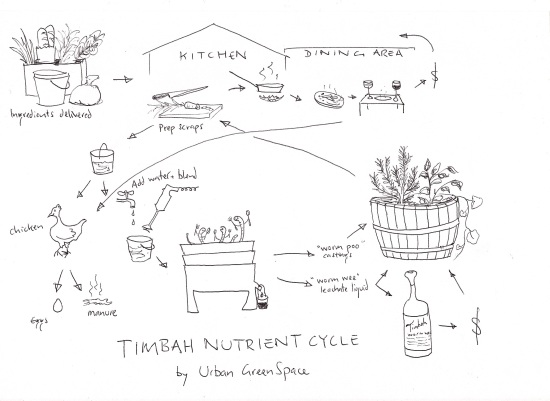
A simplified illustration of the Timbah nutrient cycle. Worms do the hard yards upstairs on the rooftop garden and the chicken picks up the slack.
Nutrient cycling method:
Primary: worms
Secondary: Arrabella the chicken
It comprises of:
3 worm farms
6 worm towers in wicking planters
a chicken
a stick blender
some small buckets with lids
a rubbish bin
helpful and cooperative staff
What it needs to be:
Simple
Systematic
Anything that is an added responsibility for someone in a restaurant (or place of work) needs to be very simple and easy. If it isn’t it won’t stick.
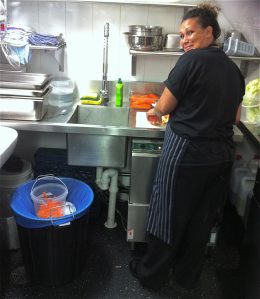
Here is the bucket-in-a-bucket system in situ. Lisa the cook is easily able to channel prep scraps easily into the smaller bucket.
For this system we have decided that it is easiest to capture food prep waste as the primary nutrient cyclers are worms. It’s far easier to sort the right things into the right bin in the quieter mornings in their raw state than it is in the later busy service times when it’s cooked and co-mingled.
When designing your system, consider:
- What organism/s will be doing the heavy lifting (or eating). If you are thinking about black soldier flies as a primary cycler, remember that during winter they are practically dormant so make sure you have a stand-in cycler at the ready
- Food safety. At each stage, the scraps are transferred to a different bucket to avoid cross contamination
- Busy times versus quieter times. When starting out and whilst staff are learning what can and can’t go into the system, it’s far easier to keep it simple and slow. As everyone gets up to speed you can try and process more like plate scrapings for critters other than worms
- Explore offsite options. Is there a regular customer who gardens? Coffee grounds are great for the garden, maybe they have a compost bin or a chicken? Can you fit them into your system? One of my other clients has all of their organic waste (food scraps, napkins, toothpicks etc) taken out to a farm. It wasn’t easy to find a farmer that would accept it all but he found one in the end. (More on this later)
- The outputs: the three worm farms at Timbah produce an immense amount of worm wee. I am currently working with the owners to bottle and sell it as a way of raising awareness of the project and offsetting some of the costs. As it is a winebar there are loads of empty bottles floating around so it makes sense to repurpose them, right? Don’t forget you will be producing worms too so perhaps there are customers who would be happy to buy them as opposed to paying for them in a big box retailer when they’ve been on the shelf for ages. If you choose black soldier flies as a means of nutrient cycling, (through the warmer months) you will have a high quality live protein source that chickens, fish, dogs and cats love to eat and will be able to process high volumes of waste.
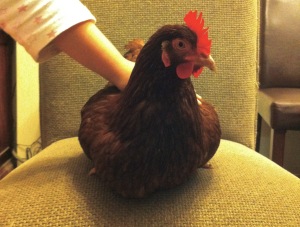
Arrabella is Timbah’s fall back nutrient cycler. She gives the chef’s family fresh free-range eggs and manure
In my kitchen-handing days I developed the “bucket-in-a-bucket” system of placing a small bin inside the larger bin so that it was easy to divert food scraps, this system is still in effect. When the scrap bucket is full it is emptied into a sealed bucket that is kept in the cool room. Once or twice a week I come in and take the bucket upstairs where I tip it into another bucket, add some water then blend it with a stick blender before giving it to the worms.
Why blend the scraps?
This comes back to “considering the organism”. When I explain this step people always say “Isn’t that a bit excessive?” but when they realise how much food waste comes out of a commercial kitchen and that it’s being handled by a bunch of worms, it becomes clear why I would do this.
Worms don’t have teeth. They feed on the bacteria on the food not the food itself. Therefore if you expose more surface area of the food it will break down faster.
Once I have fed the worms the blended veg scraps (plus coffee grounds from the bar) and before I put their insulation blanket on top, I grab a handful of shredded newspaper (some of the more expensive bottles of wine come packed with this) and place that over the top of the worms’ smorgasbord so that oxygen can get at it and start the decomposition.
Over time, the worm farms produce “worm wee” which isn’t actually wee as worms don’t have bladders. It is technically leachate and this stuff is great for plants. It’s basically a kind of plant tonic/food with loads of nutrients that are now ready for plants to absorb.
In addition to leachate, the worm farms produce worm castings, (called “worm poo”) a wonderful soil additive as it contains nutrients and beneficial microorganisms necessary for happy plants.
You will recall mention of a chicken. Chef Daphne has a chicken (Arrabella) at home which is basically the family pet. Arrabella helps process some of the overflow of waste when it is more than the worms can handle or if I haven’t been able to get there. Sometimes if the system is firing well, we divert some of the cooked service scraps to Arrabella as she is better equipped to process these (being an omnivore.) Daphne and her family get the benefits of fresh free-range eggs and highly nutrient laden chicken manure in their garden. Much as I would love to get the chicken manure back, I think it’s a big ask to bring chicken poo to work and we lack the facilities to process it here.
This system isn’t perfect. I would like to be able to process all of the organic waste but to achieve this requires key staff to be as passionate about waste reduction and nutrient cycling as I am. It also requires more space to house composting facilities. At one point in time there was a friend of the bar who lived nearby and took a bucket of scraps a week, this had the system processing close to 100% of the organic waste. I hope we can find another neighbour willing to take some nutrients. It’s a win/win offer!
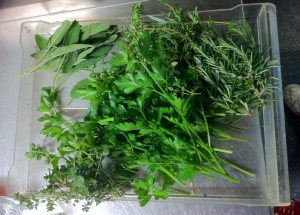
A modest early spring harvest from the rooftop garden. Nutrients cycled from the kitchen come back in the form of highly nutritious and flavourful organic herbs and vegies
I think it’s really important that we all realise how important it is to cycle nutrients. Nature does it best and we would be well served to learn from her.


